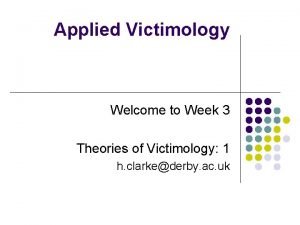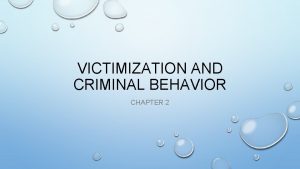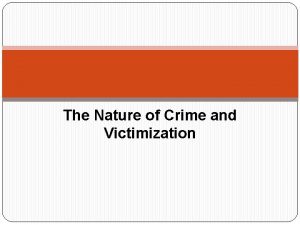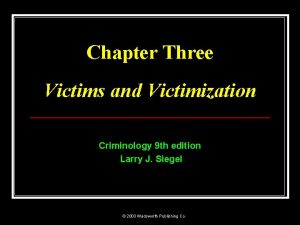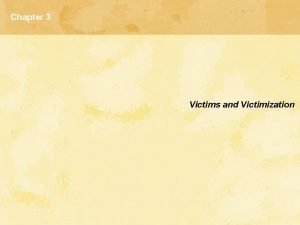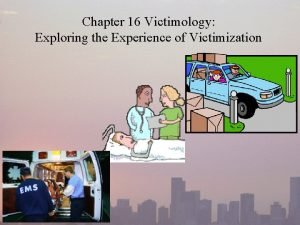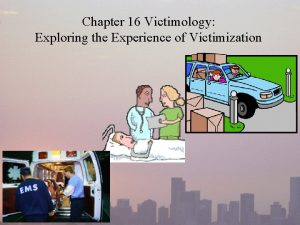Chapter 9 Environmental Theory The Nature of Victimization































- Slides: 31

Chapter 9 Environmental Theory

The Nature of Victimization �Since 1993 the number of victimizations are declining �NCVS Data �Patterns of victimization are stable �Victimization is not random �Becoming a crime victim has a lot to do with personal and ecological factors �How is this useful? �Researchers can make judgments about the nature of victimization �Efforts can be made to reduce the victimization rate

Environmental Criminology �Examines the location of a specific crime and the context in which it occurred in order to understand explain crime patterns. �Where and when did the crime occur? �What are the physical and social characteristics of the crime site? �What movements bring offender and target together at the crime site?

Rational Choice Perspective Clark & Cornish Rational Choice perspective developed by Ronald Clarke and Derek Cornish and based on two theoretical approaches 1. Based on utilitarianism, assumes that people make decisions with the goal of maximizing pleasure and minimizing pain. 2. Based on traditional economic choice theory, which argues that people will evaluate the options and choose what they believe will satisfy their needs.

�Rational choice implies a limited sense of rationality, that is, an offender does not know all the details of a situation; rather he or she relies on cues in the environment or characteristics of targets �Most crime is ordinary and committed by reasoning individuals who decide that the chances of getting caught are low and the possibilities for a relatively good pay off is high.

�A variety of factors or characteristics come into play when an offender decides to commit a crime. These factors are called “choice structuring-properties” �Characteristics fall into two distinct sets: those of the offender and those of the offence.

Decision to commit burglary Selected (Middle Class Area) Easily accessible few police patrols low security housing larger gardens Rejected (Middle Class Area) Unfamiliar; distant neighborhood watch no public transport Burgled Home no one at home: Especially affluent, detached, patio doors bushes and other cover corner site Not Burgled Home Nosy neighbors, burglar alarm nor rear access, visible from street window locks; dog

Routine-Activity Approach Cohen & Felson �A crime can occur only if there is someone who intends to commit a crime (likely offender). �Something or someone to be victimized (a suitable target). �No other person present to prevent or observe the crime (the absence of a capable guardian). �No person to control the activities of the offender (personal handler).

Components of a Criminal Event

�Routine patterns of work, play, and leisure time affect the convergence in time and place of motivated offenders who are not handled, suitable targets, and the absence of guardians �If one component is missing, crime is not likely to be committed.

Routine-Activity Approach � Certain technological changes and alterations in the workforce create new crime opportunities 1. Increase in female participation in the labor force 2. Out-of-town travel, automobile usage, and technological advances that account for higher risks of predatory victimization.

Theories of Victimization Lifestyle Theories Proposition: 1. The probability of suffering a personal victimization is directly related to the amount of time that a person spends in public places. 2. The probability of being in public places varies as a function of lifestyle. 3. Social contacts and interactions occur disproportionately among individuals who share similar lifestyles.

Lifestyle Theories Continued 4. 5. 6. An individual’s chances of personal victimization are dependent upon the extent to which the individual shares demographic characteristics with offenders. The proportion of time that an individual spends among non-family members varies as a function of lifestyle. The probability of personal victimization increases as a function of the proportion of the time that an individual spends among non-family members.

Lifestyle Theories Continued 7. 8. Variations in lifestyle are associated with variations in the ability of individuals to isolate themselves from persons with offender characteristics. Variations in lifestyle are associated with variations in the convenience, the desirability, and visibility of the person as a target for a personal victimization.

Burglars and Burglary � Before committing their offenses, burglars take into account 1. Familiarity with the area, 2. Fear of recognition 3. Concern over standing out as somebody who does not belong

Burglars and Burglary �Planning – professional burglars plan more than do amateurs �Systematic selection of a home - some burglars examine clues such as burglar alarm, watchdog, mail piled up in mailbox, accumulated newspapers. Closed windows with A/C turned off �Situational Cues – some burglars routinely choose a corner property for it offers avenues of escape, fewer adjoining properties low visibility.

Victim-Offender Interaction Marvin Wolfgang �Coined the term victim precipitation to refer to situations where victims initiate the confrontations that lead to their death. �Wolfgang estimated that as many as one quarter to one half of intentional homicides are victim precipitated.

Theories of Victimization Continued Repeat victimization Hotspots of crime Geography of crime

Repeat victimization �Dispel the myth that crime is uniformly distributed. A small number of people and places account for a large amount of the crimes committed. �Risk of repeat burglary are highest immediately after a previous burglary �Offenders choose targets based on the knowledge they gained in the previous victimization about the risks and rewards of a particular offence.

Hot Spots �Studies show that certain types of crime are concentrated in what police refers to as “hot spots” �The researchers surmise that attempts to prevent victimization should be focused not on victims but on the places themselves by making them less vulnerable to crime.

Geography of Crime Researchers have found that more crime occurs around high schools and blocks with bars, liquor stores, the city center and abandoned buildings.

The Social Ecology of Victimization �Violent crimes are slightly more likely to occur in a public area during daytime or early evening hours �More serious violent crimes typically occur after 6 p. m. to 6 a. m. �Rape and aggravated assault �Less serious violent crimes more likely occur in the day �Purse snatching and unarmed robberies

�The risk of murder is highest in disorganized inner-city areas �Rural areas have significantly lower victimization rates than urban areas (half as much) �Schools are also the location of many victimization �Numbers are decreasing

The Victim’s Household �In the U. S. certain homes are more vulnerable to crimes �Larger homes (family size) �African American �Renters �Western and urban homes � Rural white homes in the Northeast are least likely to contain crime victims

Important Victim Characteristics �Gender �Age �Social status �Marital status �Race and Ethnicity �Repeat victimization

Gender Males are more likely to be the victims of violent crimes (robbery/assault) Except for rape or sexual assault Two thirds of women are victimized by someone they know or live with Half of male victims are attacked by someone they know With the increase in gender equality, women’s victimization rates are as well Age Young people have a much higher victimization rate Victim risk rapidly diminishes after age 25 By age 65 chances of being victimized greatly decrease 1% of violent victimizations With increases in reports of elder abuse, victimization rates for the elderly will increase More likely to be victims of crimes such as Frauds and scams Purse snatching

Social Status The poorest Americans are the most likely victims of violent and property crime Regardless of age, gender, and race The wealthy are more likely the targets of personal theft crimes Marital Status Never-married men and women have higher victimization rates than married people Widows and widowers have the lowest victimization rate The relationship between marital status and victimization is probably influenced by gender, age, and lifestyle

Crime Prevention Through Environmental Design �Originated by C. Ray Jeffery �CPTED posits that environments can be altered, often at little expense, to decrease victimization. �Defensible Space by Oscar Newman refers to improved architectural designs, particularly of public housing, in order to provide increased security.

Situational Crime Prevention �The phantom crime prevention at Disney World �Situational prevention of auto theft �Convenience stores �Parking facilities �Displacement

Top 25 Most Commonly Stolen Vehicles in 2001

1995 Honda Civic 1991 Honda Accord 1989 Toyota Camry 1997 Ford F 150 Series 1994 Chevrolet C/K 1500 Pickup 1994 Acura Integra 2004 Dodge Ram Pickup 1994 Nissan Sentra 1988 Toyota Pickup 2007 Toyota Corolla Source: Intellichoice. com 2008
 Nature of victimization
Nature of victimization Theories of victimology
Theories of victimology Human behavior and victimology
Human behavior and victimology Victimization theory
Victimization theory Compliant victimization
Compliant victimization Wireless health
Wireless health Multidisciplinary nature of environmental studies;
Multidisciplinary nature of environmental studies; Sunderlal bahuguna quotes malayalam
Sunderlal bahuguna quotes malayalam Nature and nature's law lay hid in night meaning
Nature and nature's law lay hid in night meaning Determinace lidské psychiky
Determinace lidské psychiky Hát kết hợp bộ gõ cơ thể
Hát kết hợp bộ gõ cơ thể Frameset trong html5
Frameset trong html5 Bổ thể
Bổ thể Tỉ lệ cơ thể trẻ em
Tỉ lệ cơ thể trẻ em Gấu đi như thế nào
Gấu đi như thế nào Thang điểm glasgow
Thang điểm glasgow Chúa yêu trần thế alleluia
Chúa yêu trần thế alleluia Các môn thể thao bắt đầu bằng tiếng chạy
Các môn thể thao bắt đầu bằng tiếng chạy Thế nào là hệ số cao nhất
Thế nào là hệ số cao nhất Các châu lục và đại dương trên thế giới
Các châu lục và đại dương trên thế giới Công thức tính thế năng
Công thức tính thế năng Trời xanh đây là của chúng ta thể thơ
Trời xanh đây là của chúng ta thể thơ Mật thư tọa độ 5x5
Mật thư tọa độ 5x5 Phép trừ bù
Phép trừ bù Phản ứng thế ankan
Phản ứng thế ankan Các châu lục và đại dương trên thế giới
Các châu lục và đại dương trên thế giới Thơ thất ngôn tứ tuyệt đường luật
Thơ thất ngôn tứ tuyệt đường luật Quá trình desamine hóa có thể tạo ra
Quá trình desamine hóa có thể tạo ra Một số thể thơ truyền thống
Một số thể thơ truyền thống Cái miệng nó xinh thế
Cái miệng nó xinh thế Vẽ hình chiếu vuông góc của vật thể sau
Vẽ hình chiếu vuông góc của vật thể sau Thế nào là sự mỏi cơ
Thế nào là sự mỏi cơ

